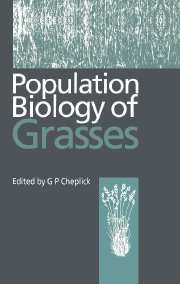Book contents
- Frontmatter
- Contents
- Contributors
- Preface
- Darwin revisited: approaches to the ecological study of grasses
- Part one Population variation and life history patterns
- 1 Allozyme diversity in the grasses
- 2 Ecology of seed dormancy and germination in grasses
- 3 Seed dispersal and seedling establishment in grass populations
- 4 Clonal biology of caespitose grasses
- 5 Ecological aspects of sex expression in grasses
- 6 Interspecific variation in plasticity of grasses in response to nitrogen supply
- 7 Population biology of intraspecific polyploidy in grasses
- Part two Ecological interactions
- Part three Population biology of specific groups
- Index
4 - Clonal biology of caespitose grasses
Published online by Cambridge University Press: 14 September 2009
- Frontmatter
- Contents
- Contributors
- Preface
- Darwin revisited: approaches to the ecological study of grasses
- Part one Population variation and life history patterns
- 1 Allozyme diversity in the grasses
- 2 Ecology of seed dormancy and germination in grasses
- 3 Seed dispersal and seedling establishment in grass populations
- 4 Clonal biology of caespitose grasses
- 5 Ecological aspects of sex expression in grasses
- 6 Interspecific variation in plasticity of grasses in response to nitrogen supply
- 7 Population biology of intraspecific polyploidy in grasses
- Part two Ecological interactions
- Part three Population biology of specific groups
- Index
Summary
Introduction
Graminoids comprise one of the largest subgroups of clonal plants among terrestrial angiosperms (Tiffney & Niklas, 1985). Caespitose graminoids represent a unique growth form that is characterized by the compact spatial arrangement of ramets within individual clones and the absence of rhizomes or stolons. Caespitose graminoids occur on all continents from the high Arctic to the Sub-Antarctic and are distributed over a wide range of precipitation zones (Leith, 1978; Walter, 1979). This growth form is particularly dominant in the grassland biome which occupies 24 million km2 including tropical and temperate grasslands, savannas and shrub steppe (Leith, 1978).
The wide distribution and dominance expressed by caespitose graminoids is somewhat surprising given that the majority of modern monocot families are rhizomatous (Tiffney & Niklas, 1985). Rhizomes are modified horizontal ramets located belowground that represent a mode of clonal growth well suited for ramet dispersal, effective resource acquisition, and resource storage (Grace, 1993). In contrast, caespitose graminoids possess several attributes that could potentially limit their success, including intense intraclonal competition for nutrients (Hartnett, 1993) and for photosynthetically active radiation (Caldwell et al., 1983; Ryel, Beyschlag & Caldwell, 1993,1994), and a limited ability to access heterogeneously distributed resources (Van Auken, Manwaring & Caldwell, 1992). This poses the question, ‘what structural and/or functional attributes contribute to the ecological success of caespitose graminoids without the benefits conferred by rhizomes?’ The adaptive value of caespitose clones must be sufficient to offset the benefits associated with rhizomes or this growth form would not be so successful (e.g. Pedersen & Tuomi, 1995).
- Type
- Chapter
- Information
- Population Biology of Grasses , pp. 106 - 135Publisher: Cambridge University PressPrint publication year: 1998
- 42
- Cited by

